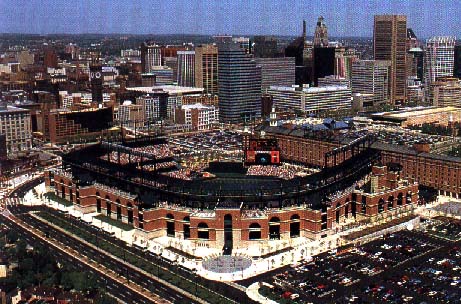| Physical Strategies | Functional Strategies |
|---|
Camden Yards
April 6, 1992; the time was 3:20 pm, the temperature 63°
It was the Cleveland Indians at Baltimore. The first batter flied out to right field on a 3-2 pitch and the first season was underway at the new Oriole Park at Camden Yards.
Camden Center was a railroad yard just west of Baltimore's Inner Harbor. Before the baseball park was constructed, the center was home to a variety of businesses, such as Southern Seafood, Parks Sausage Co. and Monumental Hotel Supply. These and other businesses were bought out after the Maryland General Assembly created the Maryland Stadium Authority and gave it the power to acquire properties that stood in the way of the proposed ballpark. The total cost of the project was $106.5 million, which was financed by a state lottery. Payments from the authority to the ousted businesses were in excess of $83.5 million, but buyouts and relocation funds did not guarantee successful transplantation--many relocated firms were out of business before the ballpark opened.1

The new stadium was designed by the architectural firm of Helmuth, Obata & Kassabaum (HOK) with input from the Orioles and the State of Maryland. The park is reminiscent of old time baseball parks like Fenway and Ebbets Field. Instead of another concrete "flying saucer" of a stadium with artificial turf, the stadium blends with the urban context of downtown Baltimore and features an arched brick facade, an asymmetrical playing field and natural turf. The ballpark includes an unusual feature just beyond right field. The B&O warehouse was built between 1898 and 1905, and is 1016' long, which makes it the longest building on the East Coast. The warehouse now contains offices for the Orioles staff and ballpark operations as well as public facilities, such as a souvenir shop, cafeteria and a bar.
Camden Yards is a ten minute walk from Baltimore's Inner Harbor and downtown. This location concerned traffic and parking planners, but at the first exhibition game approximately 35% of those attending arrived by public transportation, a figure twice as high as the planners had expected.2 The stadium can be reached by rail, bus and subway as well as by major highways. There are also about 4,000 parking spaces on-site, as well as many garages and lots located within walking distance.
Camden Yards is a new type of ballpark, combining an open air, natural turf stadium and an idiosyncratic field with state of the art concession stands and amenities. It is designed to complement the architectural idiom of its neighborhood, and once inside:
You find yourself in a remarkable exterior room bounded in part by a colossal center field scoreboard and, in the distance, the skyscrapers of Inner Harbor. It is the presence of the city in the stadium that is, in the end, most dramatic. Camden Yards is a great place to watch baseball, but it is an even better place to affirm the possibilities of the city.3
1. Kevlin C. Haire, "Move Brings Mixed Bag to Old Yard Firms," Baltimore Business Journal, v13 No. 9, (July 21, 1995) p1(2).2. Donald Prowler, "Baltimore Hits Home with new Baseball Park," Progressive Architecture, 73, No. 6 (June 1992): p26.
3. Ibid.
Bibliography
Baltimore Orioles Fact Sheet
Dawidoff, Nicholas. "Field of Kitsch: Is Nostalgia Wrecking Baseball?," The New Republic, 207, No. 8-9 (August 17, 1992) p22(3).
Haire, Kevlin C. "Move Brings Mixed Bag to Old Yard Firms," Baltimore Business Journal, v13 No. 9, (July 21, 1995) p1(2).
Kurkjian, Tim. "A Splendid Nest," Sports Illustrated, 76 No. 14 (April 13, 1992): p34(4).
Prowler, Donald. "Baltimore Hits Home with new Baseball Park," Progressive Architecture, 73, No. 6 (June 1992): p26.
Page Author: Liz Airey
| Physical Strategies | Functional Strategies |
|---|
.
